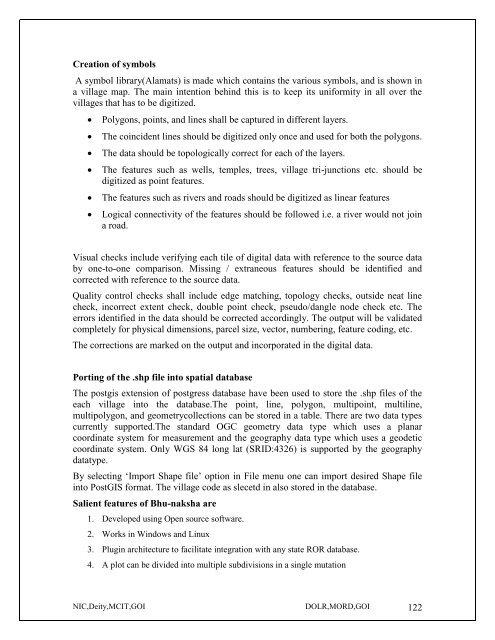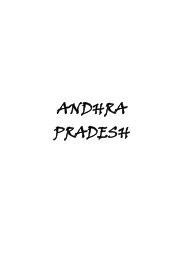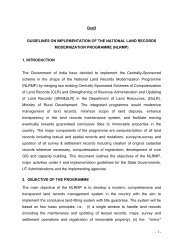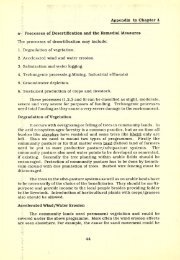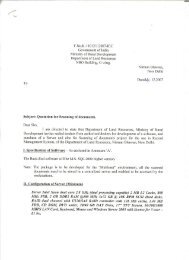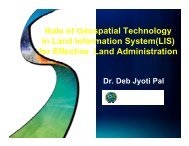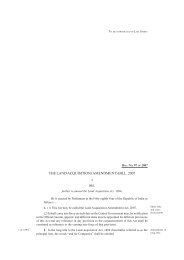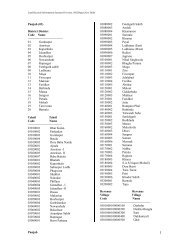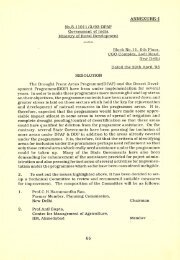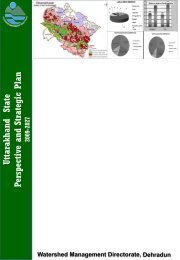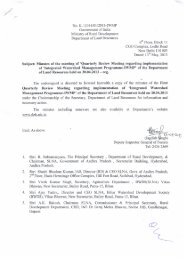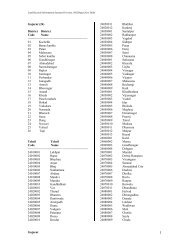Table 2 - Department of Land Resources
Table 2 - Department of Land Resources
Table 2 - Department of Land Resources
You also want an ePaper? Increase the reach of your titles
YUMPU automatically turns print PDFs into web optimized ePapers that Google loves.
Creation <strong>of</strong> symbols<br />
A symbol library(Alamats) is made which contains the various symbols, and is shown in<br />
a village map. The main intention behind this is to keep its uniformity in all over the<br />
villages that has to be digitized.<br />
<br />
<br />
<br />
<br />
<br />
<br />
Polygons, points, and lines shall be captured in different layers.<br />
The coincident lines should be digitized only once and used for both the polygons.<br />
The data should be topologically correct for each <strong>of</strong> the layers.<br />
The features such as wells, temples, trees, village tri-junctions etc. should be<br />
digitized as point features.<br />
The features such as rivers and roads should be digitized as linear features<br />
Logical connectivity <strong>of</strong> the features should be followed i.e. a river would not join<br />
a road.<br />
Visual checks include verifying each tile <strong>of</strong> digital data with reference to the source data<br />
by one-to-one comparison. Missing / extraneous features should be identified and<br />
corrected with reference to the source data.<br />
Quality control checks shall include edge matching, topology checks, outside neat line<br />
check, incorrect extent check, double point check, pseudo/dangle node check etc. The<br />
errors identified in the data should be corrected accordingly. The output will be validated<br />
completely for physical dimensions, parcel size, vector, numbering, feature coding, etc.<br />
The corrections are marked on the output and incorporated in the digital data.<br />
Porting <strong>of</strong> the .shp file into spatial database<br />
The postgis extension <strong>of</strong> postgress database have been used to store the .shp files <strong>of</strong> the<br />
each village into the database.The point, line, polygon, multipoint, multiline,<br />
multipolygon, and geometrycollections can be stored in a table. There are two data types<br />
currently supported.The standard OGC geometry data type which uses a planar<br />
coordinate system for measurement and the geography data type which uses a geodetic<br />
coordinate system. Only WGS 84 long lat (SRID:4326) is supported by the geography<br />
datatype.<br />
By selecting ‘Import Shape file’ option in File menu one can import desired Shape file<br />
into PostGIS format. The village code as slecetd in also stored in the database.<br />
Salient features <strong>of</strong> Bhu-naksha are<br />
1. Developed using Open source s<strong>of</strong>tware.<br />
2. Works in Windows and Linux<br />
3. Plugin architecture to facilitate integration with any state ROR database.<br />
4. A plot can be divided into multiple subdivisions in a single mutation<br />
NIC,Deity,MCIT,GOI DOLR,MORD,GOI 122


